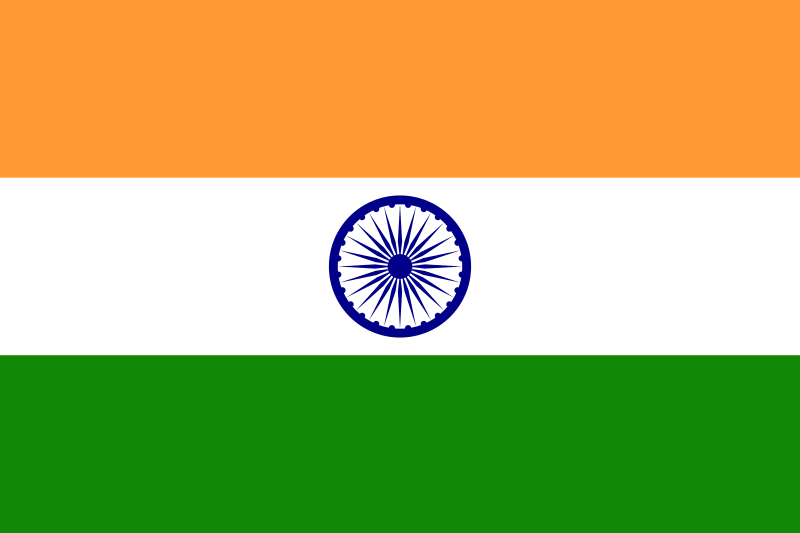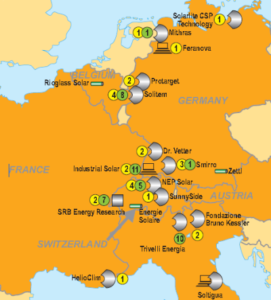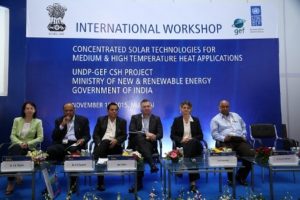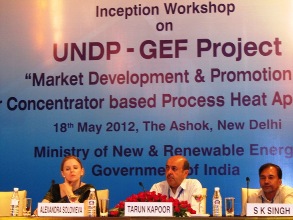India: Quarterly Sun Focus Magazine Presents Concentrating Solar Heat
September 19, 2013
The Project on Concentrated Solar Heat by the United Nations Development Programme (UNDP), the Global Environment Facility (GEF) and India´s Ministry of New and Renewable Energy (MNRE) has published the first issue of Sun Focus (see the attached document). The English-language magazine offers statistics on the market and showcases concentrating solar heat projects to make the technology more popular in India. According to the new publication, India has 145 concentrating solar thermal systems producing steam across the country, with 111 of them built over the past five years (see the table below). The dish is the country’s most popular design for concentrating solar heat and cooking is its most widespread application.
According to Sun Focus, another 23 systems with 8,100 m² are underway. They include rather small systems of two to three dishes, with a share that could be as much as 30 % of the total number. Most of them are being installed at places at which conventional boilers have already been used to generate steam for cooking.
| Company | Installations over the past 5 years |
Web page |
| Flareum* | 40 | http://www.flareum.com |
| Clique Solar | 15 | http://www.cliquesolar.com |
| Thermax | 15 | http://www.thermaxindia.com |
| Sharada Inventions |
10 | http://www.sharadainventions.com |
| Unisun Technologies |
12 | http://www.unisun.net |
| Taylormade Solar Solutions |
6 | http://www.tss-india.com |
| Others (8 companies) |
13 |
Current number of concentrating solar systems in India, amounting to 111 solar process installations over the past 5 years.
* This company has been taken off the MNRE list for not performing satisfactorily
Source: Dr Singhal, UNDP.
The MNRE offers a grant of 30 % and the UNDP-GEF project an additional subsidy of 10% for developing demonstration projects to showcase solar process heat. Profit-making entities are also entitled to 80% accelerated depreciation. The UNDP-GEF programme additionally offers workshops tailored to different customer groups. In March and May 2013 alone, the programme’s administrators held two workshops for institutions and religious centres, three for hospitals and the hospitality sector and three for the industry.
According to the magazine’s technology listing, dishes and parabolic troughs usually pay back within 3.5 to 6 years in India. Investments start at Indian Rupee (INR) 16,000 and go as high as 20,000 INR/m² of collector area (EUR 190 to 240), so it mostly varies with the size of the system. Installed in hybrid mode with back-up fuel, a 100 m² solar system can save 5,000 to 10,000 litres of diesel or 600 to 1,200 LPG cylinders per year, depending on the type of technology used and the availability of Direct Normal Irradiance (DNI).
The magazine highlights some case studies, among them the system at the Shri Saibaba Sansthan Trust in Shirdi, probably the most prestigious solar cooking system worldwide. Seventy-two dishes with 16 m² of aperture area each have been used to prepare 20,000 meals a day since 2009. What makes solar cooking especially favourable for religious centres in south and east India is that food – such as rice, dal (an Indian lentil dish) and vegetables – can be steam-cooked. The dish collectors provide steam for an advanced cooking system with alternative fuel (often LPG) as a back-up source, which means the collector is installed outside, whereas the kitchen is located inside the building.
According to Sun Focus, the ARUN dish collector developed by Clique Solar with financial support from the MNRE and technical support from IIT Bombay has already been incorporated into 15 installations in India (see the table above). The company won the Intersolar Europe award in Munich, Germany, in June 2013.
Besides cooking and industrial demand, concentrating solar thermal systems have also been used in combination with vapour absorption machines for air conditioning in buildings. One example is the system at the Thane Civil Hospital, which is comprised of 184 Scheffler dishes, each with a 13.5 m² area. The system has an integrated biomass boiler, using briquettes to run 24/7.
Other examples of solar cooling systems are the air conditioning plant at Muni Seva Ashram, situated in the Vadodara district of Gujarat state in western India. A total of 100 parabolic dishes (type Scheffler), each 12.5 m² in size, supply the existing 100 tonne air conditioning system.
More information on the UNDP project: “Market Development and Promotion of Solar Concentrators Based Process Heat Applications in India”


